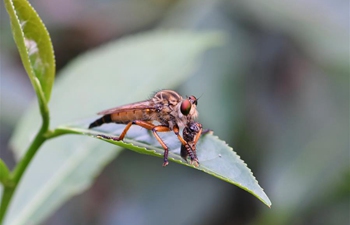CHICAGO, Aug. 28 (Xinhua) -- A study posted on the website of the University of Chicago (UChicago) on Wednesday showed that birds have strong ties to the climate patterns of their habitats, and the geographical distribution of birds may be more restricted than people think.
The researchers examined 305 species of open-habitat and tree-dwelling birds out of the known 621 species present in the Himalayas. The numbers of species were estimated over a ten-year period from reported sightings and vocalizations across 38 sites in the Himalayan forests.
They analyzed their field data by developing what's called a grade of membership model. In this model, bird species were assigned to a few groups based on their geographical patterns of coexistence.
The model allows for the possibility that each bird group be from multiple geographical areas, but it still showed little mixing of groups across the tropical-temperate divide.
Moreover, the researchers discovered that bird groups within the same climate zones also have the same evolutionary roots. This means that climate has had a long history in shaping population distributions.
"The abundances of birds that cross the freezing line seem to change according to whether or not their region of origin was the temperate or tropics," said Alex White, a former UChicago graduate student and now at National Museum of Natural History in Washington, D.C. "This is surprising because the freezing line in the Himalayas, the sharpest in the world due to the extremely steep elevation gradients, spans only tens of kilometers. Our results highlight the importance of climatic barriers to bird population distributions."
Temperate regions are not freezing all year round, only during the winter season. So why aren't Himalayan birds distributed more uniformly across the freezing line, especially during the warmer breeding months? The answer may lie in the flora of a bird's habitat.
Unlike birds, plants have very particular adaptations to freezing, and birds rely closely on the plants in their habitat. Birds are picky eaters, consuming locally specific foods, such as insects associated with the vegetation in their home.
"Our study demonstrates that bird distributions are strongly connected to a given environment, and the freezing line is really the underlying component that's changing the habitats," White said. "Birds may just be overlaid on to their habitats."
In the next step, the researchers want to study the impact of climate on the distribution of ecological attributes of birds such as beak shape, using the same model.
"Our results show that bird communities are contained by much more discrete boundaries than maybe we had previously appreciated," White said. "The movement of these discrete boundaries could have serious implications for the functioning of the ecosystem, leading to instabilities if we alter the environment that birds rely on."
The results have been published in the journal Nature Communications.

















